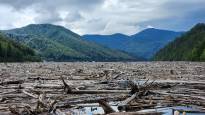Millions of cubic meters of wood were left under water when the huge Sayano-Shushenskaya hydroelectric power station was built on the Yenisei River in the Soviet Union.
HAKASSIA/KRASNOJARSK DISTRICT The ground floor of Djoisk bay is like a large wooden carpet. Barkless trees float side by side in the water in the middle of a forested Siberian mountain landscape.
The trees are by-products of a huge power plant built in the 1960s and 1970s. The large dam brought huge masses of water to the area, which buried the area under the forest.
The Sajano-Sushenskaya hydroelectric power plant is the largest electric power plant in Russia. It is located in Southern Siberia on the Yenisei River on the border of Khakassia and Krasnoyarsk districts.
It was built during the Soviet era and started operating in 1978. The power plant was not fully completed until 2000. Its dam is 242 meters high, the highest in Russia.
The Sajano-Sušenskaya power plant made international news in August 2009, when a serious accident occurred there. One of the power plant’s turbines failed and water rushed into the plant’s machine hall and the rooms below it. 75 people died. The power plant’s repair work took five years.
The event raised fears among the residents of the population centers located below the dam, although the authorities assured that the dam was not in danger of breaking. More broadly, Turma raised questions about whether the infrastructure inherited from the Soviet era had been allowed to fall into too poor condition.
The wooden heritage rises from the bottom of the artificial lake
A much less dramatic but very long-term problem has been lurking at the bottom of the dam basin.
As in many large hydropower projects of that time, large areas of forest remained at the foot of the Sajano-Sušenskaya dam.
In the rush of construction, there was no time to cut down and transport the wood, so an estimated 3 million cubic meters of forest remained at the bottom of the artificial lake. These trees are still coming up decades after the project.
Driftwood hinders boat traffic and threatens the operation of the power line. A huge amount of decaying wood degrades the water quality. Decomposition processes take large amounts of oxygen, which harms the fish population and aquatic vegetation.
Problems arose in the 90s, and log booms were built to protect the power plant. In 2009, the Russian Water Resources Agency started a program to harvest wood from water.
Since 2019, at least 114,000 cubic meters of wood have been harvested from the water. This year from the artificial lake formed by the dam is to be collected away in total, almost 8,000 cubic meters of wood from an area of 183 hectares.
It has not been easy to find a use for the collected wood. There is that tried to use among others, as a raw material for arbolite, i.e. wood concrete.
